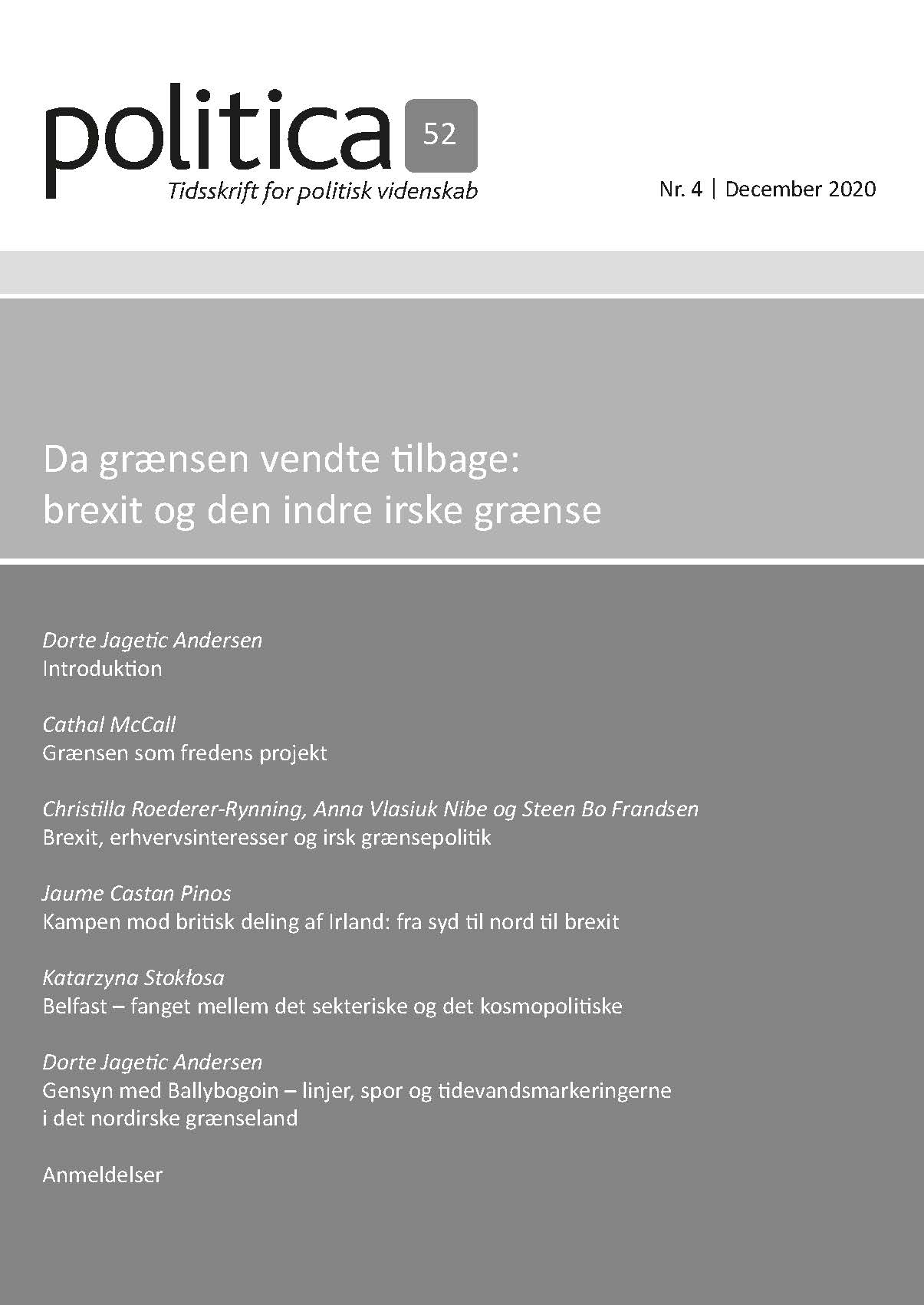Grænsen som fredens projekt
DOI:
https://doi.org/10.7146/politica.v52i4.130830Nøgleord:
grænseoverskridende samarbejde, fredsopbygning, europæisk integration, Nordirland, brexitResumé
Fredsopbygning i europæiske grænselande kræver kontakt, det kræver kommunikation, og det kræver samarbejde på tværs af statsgrænser og på tværs af etniske og nationale skel. Respekt for kulturelle forskelle er det ledende princip for dette projekt, hvor klager over naboen bliver adresseret, og stereotyper udfordret med det formål at tackle angst og mistro. Ikke desto mindre har EU’s økonomiske fokus krydret med det 21. århundredes fokus på ”sikkerhed” betydet, at det grænseoverskridende samarbejde forstået som fredsopbygning er et tilsyneladende forladt håb bag ”Europas døre”. Schengens grænseregime og den europæiske naboskabspolitik er tvillingedynamikker, som efter sigende sikrer EU’s ”eksterne fronter” mod (forestillingen om) en række fjender på flere fronter – internationale terrorister, omstridte migranter og transnationale gangstere – og tilsvarende underminerer dette sikkerhedsregime ”den bløde grænse-tilgang” til fredsopbygning på tværs af netop disse fronter. I konteksten af grænsers genkomst kunne den europæiske integration meget vel ændre sig fra mellemstatslig og grænseoverskridende fredsopbygning til, at der igen appelleres til Europas arv af grænsekonflikter og tvangsforanstaltninger på bekostning af freden.
Referencer
Agnew, John (2013). Thinking about borders: Not just on the ground but also in the mind, pp. 315-328 i Peter Gilles, Harlan Koff, Carmen Maganda og Christian Schulz (red.), Theorizing Borders Through Analyses of Power Relationships. Bruxelles: P.I.E. Peter Lang.
Andersen, Dorte Jagetic (2020). Gensyn med Ballybogoin – linjer, spor og tidevandsmarkeringerne i det nordirske grænseland. Politica 52 (4): 420-437.
Blok, Anton (1998). The narcissism of minor differences. European Journal of Social Theory 1: 33-56.
Brambilla, Chiara (2015). Navagating the Euro/African Border and migration nexus through the borderscapes lens: insights from the LampadusaInFestival, pp. 111-122 i Chiara Brambilla, Jussi Laine, James W. Scott og Gianluca Bocchi (red.), Borderscaping: Imaginations and Practices of Border Making. Farnham: Ashgate.
Britton, Karl (2000). Communication: A Physical Study of Language. London: Routledge.
Browning, Christopher S. og Pertti Joenniemi (2008). Geostrategies of the European Neighbourhood Policy. European Journal of International Relations 14 (3): 519-551.
Erőss, Ágnes, Béla Filep, Károly Kocsis og Patrik Ta’trai (2011). On linkages and barriers: The dynamics of neighbourhood along the state borders of Hungary since EU Enlargement, pp. 69-93 i Heidi Armbruster og Ulrike Hanna Meinhoff (red.), Negotiating Multicultural Europe: Borders, Networks, Neighbourhoods. Basingstoke: Macmillan.
Hann, Chris (1998). Nationalism and civil society in Central Europe: From Ruritania to the Carpathian Euroregion, pp. 243-257 i John A. Hall (red.), The State of the Nation: Ernest Gellner and the Theory of Nationalism. Cambridge: Cambridge University Press.
Janschitz, Suzanne og Andrea Ch. Kofler (2004). Protecting diversities and nurturing commonalities in a multicultural living space, pp. 193-213 i Vera Pavlakovich-Kochi, Barbara J. Morehouse og Doris Wastl-Walter (red.), Challenged Borderlands: Transcending Political and Cultural Boundaries. Aldershot: Ashgate.
Machiavelli, Niccolò (2011) [1532]. The Prince. London: Penguin.
McCall, Cathal (2011). Culture and the Irish border: Spaces for conflict transformation. Cooperation and Conflict 46 (2): 201-221.
McCall, Cathal (2014). The European Union and Peacebuilding: The Cross-Border Dimension. Basingstoke: Palgrave Macmillan.
McCall, Cathal (2018). Brexit, bordering and bodies on the Island of Ireland. Ethnopolitics 17 (3): 292-305.
Newman, David (2006a). The lines that continue to separate us: Borders in our ‘borderless’ world. Progress in Human Geography 30: 143-161.
Newman, David (2006b). Borders and bordering: Towards an interdisciplinary dialogue. European Journal of Social Theory 9: 171-186.
O’Dowd, Liam (2002). The changing significance of European borders. Regional and Federal Studies 12 (4): 13-36.
O’Dowd, Liam (2010). From “borderless world” to “world of borders”: Bringing history back in. Environment and Planning D: Society and Space 28: 1031-1050.
Pollak, Andy (2011). Cross-border cooperation as part of the Irish peace process: Opportunities, impacts and challenges, pp. 135-144 i Uprava, vol. IX, vol. 2.
Rajaram, Prem Kumar og Carl Grundy-Warr (2008). Introduction, pp. ix-xi i Prem Kumar Rajaram og Carl Grundy-Warr (red.), Borderscapes: Hidden Geographies and Politics at Territory’s Edge. Minneapolis: Minneapolis University Press.
Ringdal, Kristin og Albert Simkus (red.) (2012). The Aftermath of War: Experiences and Social Attitudes in the Western Balkans. Farnham: Ashgate.
Smith, Karen E. (2005). The outsiders: the European Neighbourhood Policy. International Affairs 81 (4): 757-773.
Sparke, Matthew (2002). Not a state, but more than a state of mind: Cascading Cascadias and the geoeconomics of cross-border regionalism, pp. 212-238 i Markus Perkmann og Ngai-Ling Sum (red.), Globalization, Regionalization and Cross-Border Regions. Basingstoke: Palgrave Macmillan.
Stokłosa, Katarzyna (2014). The border in the narratives of the inhabitants of the German-Polish Border region, pp. 257-274 i Katarzyna Stokłosa og Gerhard Besier (red.), European Border Regions in Comparison: Overcoming Nationalist Aspects or Re-Nationalization? Abingdon: Routledge.
Stokłosa, Katarzyna (2020). Belfast – fanget mellem det sekteriske og det kosmopolitiske. Politica 52 (4): 402-419.
Szabó, Gyula og Gábor Koncz (2006). Transboundary interaction in the Hungarian-Romanian border region: A local view, pp. 163-170 i James Wesley Scott (red.), EU Enlargement, Region Building and Shifting Borders of Inclusion and Exclusion. Aldershot: Ashgate.
Zeilinger, Bernhard (2012). The EU’s external policy towards Eastern Europe on migration issues, pp. 60-80 i Klaus Bachmann og Elżbieta Stadtmüller (red.), The EU’s Shifting Borders: Theoretical Approaches and Policy Implications in the New Neighbourhood. Abingdon: Routledge.
Dokumenter
X: http://www.nicva.org/sites/default/files/d7content/attachments-resources/peace_iv_report_-_final_1_4.pdf and https://www.osce.org/cio/90147?download=true (sidst besøgt 30/11/2019).
XI: In The European Union and Cross-border Co-operation in Ireland at http://www.crossborder.ie/events/Lessons_Colgan.ppt#463,11 (sidst besøgt 20/12/2019).
Downloads
Publiceret
Citation/Eksport
Nummer
Sektion
Licens
LicensOphavsretten tilhører Politica. Materialet må ikke bruges eller distribueres i kommercielt øjemed.





